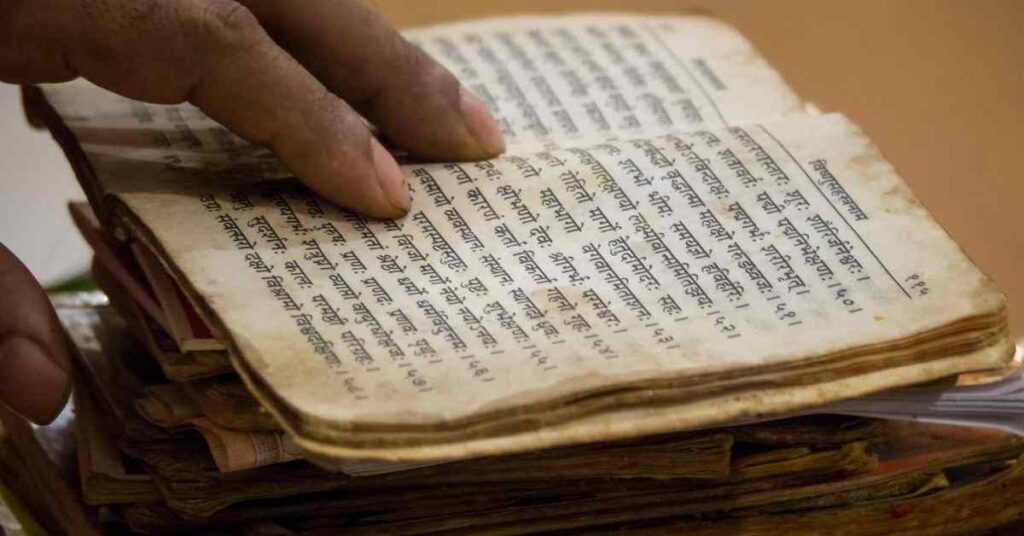The Bhagavad Gita, a jewel of Indian spiritual literature, stands as a monumental discourse embedded within the Mahabharata, one of the two great Sanskrit epics of ancient India.
Its verses, suffused with profound wisdom, have guided countless individuals on their spiritual journeys and have become the bedrock of Hindu philosophy. Yet, the question endures, “Who wrote the Bhagavad Gita?” This authorship debate, rooted in the confluence of history, theology, and belief, sparks a narrative as compelling as the teachings themselves.
The Authorship Debate: Perspectives and Theories
The Bhagavad Gita is a 700-verse scripture that is a crucial part of the Mahabharata. The text is a dialogue between Prince Arjuna and the god Krishna, who serves as his charioteer. However, the identity of the actual author or authors remains shrouded in the mists of antiquity. There are several schools of thought regarding the authorship, and delving into each proffers a deeper understanding of the complexities involved.
Krishna as the Eponymous Author
Believers deeply rooted in the Vaishnavite tradition assert that the Bhagavad Gita was divinely imparted by Lord Krishna, an avatar of the god Vishnu, himself. This viewpoint aligns with the Gita’s narrative, which features Krishna offering timeless wisdom to Arjuna. From this perspective, the teachings are a sacred revelation that transcends the limitations of human authorship.
An important historical context here is the war of Kurukshetra, where the Mahabharata was set. It is during this seminal conflict that Krishna, serving as Arjuna’s charioteer, imparts the spiritual discourse, which is fundamentally about principles of conduct and duty. The clout of this traditional belief system remains staggering, with Krishna standing as an eternal figure in the pantheon of Hindu deities.
Other Possible Authors: Alternative Theories in the Fray
Divergent voices, however, present alternative theories that challenge the orthodoxy of divine authorship. Some historical critics argue that the Gita may be a later insertion into the Mahabharata, attributed to different authors or redactors. The rationale behind these claims ranges from the linguistic and thematic differences within the epic to the sociopolitical climate that may have influenced its writing.
For instance, Maharishi Dayananda Saraswati, an influential Hindu religious leader, postulated that the Bhagavad Gita was not part of the original Mahabharata and could have been composed by gurus at the time when the Upanishads were written. This theory brings to light the possibility of multiple authors whose teachings were compiled into the Gita’s coherent body of knowledge.
Unveiling the Bhagavad Gita’s Multifaceted Origins
The Bhagavad Gita’s authorship reflects the complexity of its origins, woven intricately with the spiritual and historical fabric of ancient India. Religious conviction often shapes the belief in divine entities like Krishna, whose authorship is considered beyond contestation by many.
Amidst the Voices of Scholars: The Academic Spin on Authorship
Beyond the realm of faith, scholars and academics draw from linguistic, historical, and textual analysis to offer insights into potential authorial voices. Many renowned scholars, such as Swami Vivekananda and A.C. Bhaktivedanta Swami Prabhupada, have dedicated a significant portion of their work to interpreting the Gita, tracing its origins, and providing context.
They often cite the literary style of the Gita, which is unique compared to the rest of the Mahabharata, and the philosophical depth that resonates with the earlier Upanishads. This stylistic and thematic variance serves as a cornerstone for the argument that the Gita might have distinct authorship within or outside the realm of the Mahabharata’s acknowledged composers.
The Ineffable Message: Bhagavad Gita’s Enduring Teachings
Regardless of the scholarly discourse and historical speculation, the Bhagavad Gita’s ultimate significance lies in its teachings. The Gita addresses existential dilemmas, the nature of reality, and the concept of duty, rendering it not merely a historical text but a perennial guide for life and self-discovery.
Bridging Ancient Wisdom with Modern Mentality
The Gita’s message grapples with universal dilemmas that remain as relevant today as they were centuries ago. It transcends religious boundaries, resonating with individuals from all walks of life who seek to navigate life with clarity and purpose. The themes of detached action, moral choices, and the pursuit of knowledge are not mere artifacts of the past but are living philosophies that continue to shape and transform contemporary thought.
Spiritual Seekers and the Bhagavad Gita: A Dialogue with the Self
For the spiritual seeker, the Bhagavad Gita represents a dialogue not just between two characters but with the reader’s own existential quandaries. It poses profound questions about the self, duty, and the divine that demand introspection and contemplation. By doing so, the Gita becomes a personal scripture, intertwining its narrative with the reader’s journey.
The Continuing Luminosity of Bhagavad Gita’s Authorship
As we contemplate the age-old mystery of the Bhagavad Gita’s authorship, it is evident that this debate is more than mere historical posturing. It encapsulates the fervour of spiritual revelation, the intrigue of textual analysis, and the tenacity of enduring belief systems. The Bhagavad Gita’s legacy endures not because of who wrote it, but because of what it says. Its teachings provide a beacon for the soul, impervious to the shifting sands of authorship disputes.
A Shift in Focus: From the Author to the Message
In closing, perhaps the greatest revelation that one can glean from the Bhagavad Gita and its authorship debate is the transitory nature of human identity and the everlasting essence of truth. As we continue to unravel the enigma of the Gita, the true answer may lie not in the past but in the present—a testament to the timeless wisdom it imparts. For the reader, the path to truth is not through authorship but through the sincere and contemplative engagement with its teachings. This is where the true essence of the Bhagavad Gita resides, beyond the veils of time and the divisions of who wrote what.


